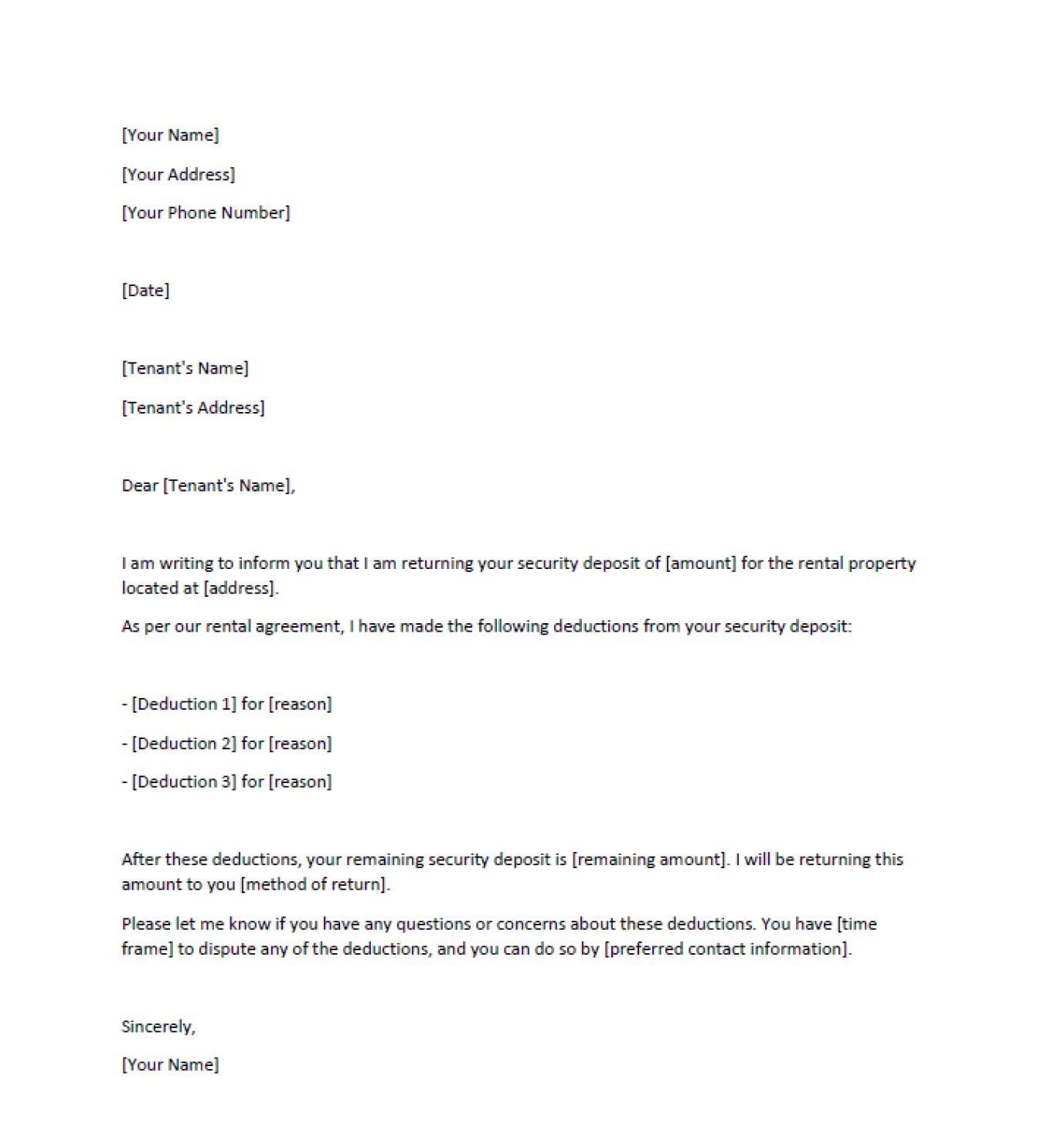As a landlord, there are many events where written notice is advised or required.
One of those instances is when the security deposit is returned.
In these cases, the landlord should write the tenant a security deposit return letter.
However, knowing precisely what the security deposit return letter is or what it should contain can be challenging.
So, in this guide, we will explain just that and even provide a free template.
Let's first go over what a security deposit letter is and why it's so important.
What Is A Security Deposit Return Letter?
A security deposit return letter is a document sent by a landlord to a tenant at the end of a tenancy.
This letter is used to inform the tenant of the amount of their security deposit that is being returned to them, as well as any deductions made from the deposit.
The purpose of a security deposit return letter is to provide a written record of the transaction between the landlord and tenant. This letter should include things like:
- Amount of the deposit that was paid at the beginning of the tenancy
- Any deductions that have been made
- The final amount of the deposit that is being returned to the tenant
…and any other relevant information. Later in the article, we will go more in-depth into what the letter should include.
The letter should also include the reason for any deductions that have been made. This could include things such as damage to the property or unpaid rent.
Now, before learning how to write a security deposit letter, we should first discuss why it's so important.
Why Is The Security Deposit Return Letter Important?
It is essential for the landlord to provide the tenant with a written record of the security deposit transaction, as this can help to avoid disputes and provide evidence if a dispute does happen.
In the event of a dispute, the landlord and tenant may need to seek legal assistance to resolve the issue. It is crucial for both parties to have all relevant documents, including the security deposit letter and inventory, to support their case in a small claims court.
This is why the security deposit letter should be signed by both the landlord and the tenant. After that, both parties should keep a copy for their records.
Before making deductions on the letter, however, the landlord must know exactly what they can and cannot deduct from the deposit.
In the next section, we will discuss some things a landlord can count as deductions from the security deposit.
What Can Landlords Deduct From The Security Deposit?
As mentioned before, one of the aspects of calculating the tenant's security deposit refund is figuring out what to deduct from it.
However, knowing what counts as deductions is imperative before sending out the security deposit return letters. Below, we have provided lists of things the landlord can and cannot count as deductions from the security deposit.

Allowed Deductions
Here is a list of some common things that can be deducted from a security deposit:
Damage to the property: If the tenant causes damage to the property, the landlord may be able to deduct the cost of repairs from the security deposit.
Unpaid rent: If the tenant fails to pay their rent, the landlord may be able to deduct the outstanding amount from the security deposit.
Cleaning fees: If the tenant leaves the property in a dirty condition, the landlord may be able to deduct the cost of repair and cleaning bills from the security deposit.
Key replacement: If the tenant loses their keys, the landlord may be able to deduct the cost of replacing the keys from the security deposit.
Lease Agreement Breaches: If the tenant breaches the lease agreement in a way that costs the landlord money, that can also be deducted from the security deposit.
If there are no required deductions from the security deposit, the landlord should return the entire security deposit to the tenant.
Deductions That Are Not Allowed
Here is a list of some common things that cannot be deducted from a security deposit:
Normal wear and tear: The landlord cannot deduct the cost of normal wear and tear from the security deposit. For example, if the carpet shows signs of normal wear and tear, the landlord cannot deduct the cost of replacing the carpet from the security deposit.
Improper deductions: The landlord cannot make improper deductions from the security deposit. For example, the landlord cannot deduct the cost of painting the entire property from the security deposit if only one wall was damaged by the tenant.
Late fees: The landlord cannot deduct late fees from the security deposit. Late fees are separate from the security deposit and should be paid directly to the landlord.
Interest: The landlord cannot deduct interest from the security deposit. If the landlord does return the security deposit interest, they may be liable for legal prosecution.
Again, it is essential for the landlord to carefully document any deductions from the security deposit and include them in the security deposit return letter.
This, along with an explanation for the deductions, can significantly help reduce the risk of a legal dispute.
So, now that we know all about security deposit return letters and what can/cannot be included in them, let's get into the most important part:
How to write one.
In the next section, we will discuss how to write a simple security deposit return letter and even provide a free template!
How To Write A Security Deposit Return Letter
Writing a security deposit return letter is a straightforward process, but it's essential to do it correctly. Landlords should always check their state laws, as they may require the letter to be in the form of a financial statement or have other restrictions.
Below, we have provided all the necessary steps to correctly write a security deposit return letter.

1. Contact Information
Start by including your contact information and the date of the letter. This will help the tenant know who the letter is from and provide a reference point for any future communication.
2. Rental Property Overview
Next, provide a brief overview of the rental property and the tenant's rental agreement. This will help the tenant understand the letter's context and verify that it is indeed for their rental property.
3. Deductions
Next, outline any deductions that have been made from the tenant's security deposit. Be sure to include the reason for each deduction, and provide any supporting documentation if possible.
For example, if you deducted money for cleaning, you might include receipts for the cleaning services.
4. Remaining Balance
If the tenant has any remaining security deposit, be sure to include information about how and when it will be returned to them. The amount listed here should equal the original security deposit minus any deductions.
This could be a check sent through the mail or a direct deposit into their bank account.
5. Disputes
Finally, include any relevant information about the tenant's rights to dispute any deductions. This might include information about the time frame in which the tenant must dispute the deductions and how they can do so.
And that's it! You have now written a complete security deposit return letter for your tenant.
If you would like a free template to help you write your own security deposit letter, be sure to visit DoorLoop's Resources Page.
Bottom Line
In conclusion, a well-written security deposit return letter can help prevent disputes and ensure that both the landlord and tenant are aware of their obligations.
This is why it is vital to pay close attention to how the letter is being written and ensure that all of the steps above are followed correctly.
































.svg)
.svg)

